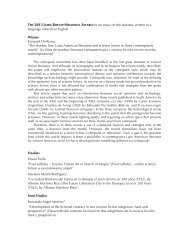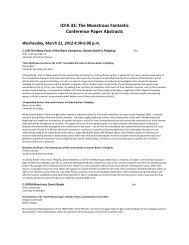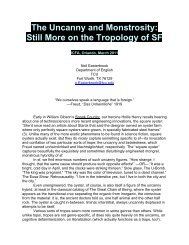118. (CYA) Fairy Tale Monsters MapleChair: C.W. Sullivan IIIEast Carolina UniversityIs the <strong>Fantastic</strong> Fairytale Grounded in Reality?: Searching Intertextually for Cultural Origins of the <strong>Fantastic</strong> Elements of FairytalesStella ReinhardVirginia Commonwealth University<strong>The</strong> child reader of fairytales may view these stories’ fantastic elements as inexplicably “magical,” created in the mind of some long agostoryteller and not grounded in the real world these children know—for what reality contains transforming pumpkin carriages and impracticalglass slippers? However, many of the most fantastic elements of classic fairy tales may actually be grounded in the historical reality of thecultures in which these stories traveled. If one views the ancient network of travelers, and the commercial hubs through which these travelerspassed as an early, primitive and much slower counterpart to the worldwide web, then cities would have acted as server collection points for allthe information that travelers would have shared about their adventures in far-off corners of the world. At these hubs, oral tales told at publicfountains and pubs would have been sent forth in new directions. Since methods of travel and communication during this part of history weremuch slower than they are today, it would have taken months, years or even decades for information to travel from one region of the world toanother. During that travel time, with primarily oral dissemination of stories, tales could inevitably have evolved and taken on some of thetrappings of the cultures through which they traveled. It should be possible, theoretically, to examine a popular folk tale and trace the historicaland cultural origins of some of its iconic fantastic elements by examining versions of the tale from around the world while simultaneouslyconsidering the cultural traditions of those regions. In this paper, I select a common variation of the Cinderella tale for examination and thenreview ancient versions of that variation from different time periods and cultures to attempt to determine the practical origin of the story’smost fantastic motifs.Escaping the <strong>Monstrous</strong> Husband: Reading Heroine’s Agency in Three Traditional TalesKate GoddardHollins University<strong>The</strong> Aarne-Thompson tale types 311, 312, and 955 (Bluebeard, Fitcher’s Bird, and <strong>The</strong> Robber Bridegroom, respectively) share the commonthread of the story’s heroine discovering that her new husband (or husband-to-be) is secretly a serial murderer, then finding a way to bothescape the fate of his other victims and expose him to the world. While the bulk of scholarship on these tales (in particular the “Bluebeard” taletype, 311) has focused on the heroine’s transgressive actions which lead her to discover the murders, virtually none have discussed the tacticsshe then employs to survive and triumph. In this paper, I will argue that the heroines in these tales assume the role of trickster, allowing themto prevail against a foe they cannot match in physical strength alone. This study will focus primarily on three versions of these tales: “Fitcher’sBird” and “<strong>The</strong> Robber Bridegroom,” both from the brothers Grimm, and “Mr. Fox” from Joseph Jacobs’s collection English Fairy Tales. I willoutline the ways in which the heroines use courage, resourcefulness, and quick thinking to save themselves from a dreadful fate and to exposetheir husbands or fiancés’ murderous nature, and how their strategies parallel those employed by traditional trickster characters. In the vastmajority of these narrow-survival tales, the heroines’ tactics and actions are positive in their result and implicitly deserving of praise, withCharles Perrault’s “Bluebeard” being the most notable exception. It is not mindless obedience of authority that they teach but rather thestrength and cunning required for self-preservation in the face of evil.Monster, Monster On the Wall: An Exploration of the <strong>Monstrous</strong> <strong>Fantastic</strong> in Fairy Tale Picture BooksMelissa SchuitSimmons CollegeHow are monsters illustrated in modern fairy tale picture books? Depictions of the fantastic monsters in fairy tales rely on the idea of theunknown, often blurring, obscuring, or shadowing that which the protagonist fears. However, these fantastic monsters can be classified intotwo major categories, the beastly monster and the human monster, and though there are strong similarities in their depictions there are alsomajor discrepancies. <strong>The</strong> beastly monster in fairy tale picture books is often blurred, distorted, partially obstructed, or even silhouetted. BothEd Young’s Lon Po Po and Daniel Egnéus’ Little Red Riding Hood obscure the wolf in their illustrations to heighten the mystery of the creatures.Young often uses the scenery around the wolf to heighten the sense of tension of the illustration and, because the wolf blends into the sky or ishidden behind a tree, neither the children nor the beholder can be sure of what the monster really looks like. Similarly, Egnéus’ never showsthe wolf in its entirety; rather Egnéus silhouettes his fantastical monster and depicts only parts of it at a time which creates an aura of mysterysurrounding the wolf. Like those of the beastly monster, depictions of evil humans in fairy tale illustrations are highly ominous. However, ratherthan using the environment to obscure the story’s monster, Paul O. Zelinsky’s Rapunzel and Ai-Ling Louie’s Yeh-Shen: A Cinderella Story FromChina depict the monstrous humans with darker skin that that of the protagonists; shadows fall over the faces of the evil humans, obscuringand altering them beyond recognition. <strong>The</strong>se distortions, as well as those of the beastly monster, serve to heighten the tension of the story anddraw the beholder into the realm of the fantastical monster.
117. (FTV) Monsters and Superheroes CypressChair: Terry M. WeynaIndependent ScholarSuperman vs. Superman: <strong>The</strong> Juxtaposed Clarks of Smallville and It's Superman!Haley HerfurthUniversity of AlabamaAt a basic level, Superman has been the same since his 1938 debut in Action Comics. <strong>The</strong>re’s always the super strength, the super speed, theinnate morality, the chiseled jaw. However, two 21st-century re-imaginings of the hero—Tom De Haven’s 2005 novel It’s Superman! and theCW’s 2001-2011 television series Smallville, created by Alfred Gough and Miles Millar—present interesting contrasts in the ways both Clarksinteract not only with their friends and adoptive parents, but with their powers, their careers and their worlds. Most striking are the differentways Clark chooses to reveal his true identity to others. Clark in Smallville fears rejection by those who know about his superhuman abilities;Clark in It’s Superman! fears rejection for exactly the opposite reason, his average intelligence and personality. <strong>The</strong>se personality differencesspring from different treatments of Clark’s origin story. While the basic facts inherited from co-creators Jerry Siegel and Joe Shuster remain thesame in both texts, each associates Clark's advent with a larger disruptive phenomenon, ones strikingly different in nature and long-term effect.In Smallville, Clark’s arrival on Earth is accompanied by a meteor shower that scatters across the entire town pieces of green Kryptonite,radioactive projectiles left over from the explosion of Clark’s home planet. <strong>The</strong>se meteorites have profound effects on the town, including fatalones. This gives Clark ample reason to feel guilty about his association with the cataclysm; better to distance himself, and to be viewed as theaverage boy next door. In It's Superman!, on the other hand, Clark's adolescence coincides not with an extraterrestrial disaster, but aneconomic one: <strong>The</strong> Great Depression—which De Haven identifies in Our Hero, his non-fiction book on Superman, as crucial to the character'screation and early development. As De Haven's Clark explores himself, he simultaneously explores the striking, larger-than-life juxtapositions ofthe Depression landscape, from Hollywood make-believe to Art Deco skyscrapers, from small-town lynchings to big-city corruption. This givesClark ample reason to feel his own inadequacies, his counterintuitive powerlessness in the face of such overwhelming forces of change. <strong>The</strong>wide variety of contrasts between It’s Superman! and Smallville might lead some to argue they aren’t worth comparing. However, the noveland the television series represent simultaneous modern reinterpretations of Clark Kent. <strong>The</strong>se alternate Clarks serve as interesting windowsinto the adaptations and alternative storylines with which Superman writers and producers are experimenting with "Our Hero" in the 21stcentury.Frankenstein on the Screen in the 21st Century: Adaptations of Shelley's Novel Since the Year 2000Brian RappIndependent ScholarI would like to offer an analysis of how Frankenstein has been adapted to the screen since 2000. Obviously the novel has inspired andinfluenced a plethora of film and television adaptations in the 20 th and 21 st centuries (e.g. the Hammer movies, the classic Universal films, etc.),so to do a presentation on all of this would be broad and could not possibly cover everything. But it is interesting how the story has beenadapted over the past 11-12 years. I am not just referring to direct versions of the story, but also those that might be loosely based on thenovel, or at least contain some of the characters (such as Victor Frankenstein’s monster) or narratives. One of the films that would be discussedwould be Van Helsing (2004), in which the monster is an important character. <strong>The</strong>re was also a made-for-TV version of Frankenstein producedby Martin Scorsese in 2004 that merits discussion. Also in 2004, there was a television mini-series (the DVDs are now distributed by theHallmark channel) that follows the book more closely. Also, Frankenstein vs. the Creature from Blood Cove, written and directed by WilliamWinckler, was made in 2005 and has not received much scholarly attention, mainly because it was never released in theaters. Another madefor-televisionversion of Frankenstein was produced in 2007 in the U.K. (though I am not positive whether I can get a copy of the DVD at themoment, but will try), which also might be worth analyzing. Finally, Frankenstein’s monster shows up in Eben McGarr’s House of the Wolf Man(2009), which also should be pointed out. (Though they will not have been out yet, it might be worth discussing or speculating about some ofthe future adaptations such as I, Frankenstein (2013) and Bruce vs. Frankenstein (presumably 2012).) In all of these films, I want to look at howMary Shelley’s story—and/or her characters—are depicted and how they differ from one another from a comparative standpoint. Oneinteresting book is Costas Constandinides’ From Film Adaptation to Post-Celluloid Adaptation: Rethinking the Transition of Popular Narrativesand Characters Across Old and New Media. Also, it would be interesting to compare these versions to some of the traditional portrayals ofFrankenstein. In doing so, I will review and analyze some of Caroline Picart’s book, <strong>The</strong> Cinematic Rebirths of Frankenstein. I will also likelydiscuss some reviews of the films analyzed."Let's Just Say I'm Frankenstein's Monster, and I'm Looking for My Creator”: Mary Shelley's Mutant Progeny in X-Men: First ClassKayley ThomasUniversity of FloridaIn the introduction to the 1831 edition of Frankenstein, Mary Shelley “bid my hideous progeny go forth and prosper” and so it has, from nearlyinstantaneous stage adaptations to the earliest of cinema, from direct adaptations to more ambiguous descendants. Victor Frankenstein’sMonster persists as an imposing figure not only in science fiction and horror but as a profoundly powerful part of a broad cultural mythos. Thusin the 2011 blockbuster reboot X-Men: First Class, Erik Lehnsherr (aka Magneto) is able to announce, “I’m Frankenstein’s Monster, and I’mlooking for my creator,” and evoke a rich and popular rhetoric for discussing the film’s exploration of what it means to be human – and what itmeans to be monstrous. In Representations of the Post/Human: Monsters, Aliens and Others in Popular Culture, Elaine L. Graham traces agenealogy of what she calls “boundary-creatures,” monsters (among them Frankenstein’s) that “mark the fault-lines” of the boundariesbetween humans and almost-humans that serve “also, subversively, to signal the fragility of such boundaries” (12). I posit that the mutants ofX-Men serve precisely as such boundary-creatures, the emerging race of the homo superior somewhere between the human and the posthuman.Matthew Vaughn’s film in particular depicts the first public manifestation of mutantkind and the early partnership between Professor
- Page 4 and 5:
5. (F) Wondrous Bodies of the Gende
- Page 6 and 7:
Fantastic Suicide: Reading the Unca
- Page 8:
Viral Posthumanism: Boundaries and
- Page 11 and 12:
The Concept of Soul Divisibility in
- Page 13 and 14:
Thursday, March 22, 2012 10:30 a.m.
- Page 15 and 16:
21. (CYA) Terrifying Futures: Post-
- Page 17 and 18:
23. (FTV/H) Now I’m Feelin’ Zom
- Page 19 and 20: Fight Club: Amalgam of the Horrific
- Page 21 and 22: Taking the Monsters out of the Clos
- Page 23 and 24: Kaspar J. SaxenaIndependent Scholar
- Page 25 and 26: 44. (CYA) The Monstrosity of Teenag
- Page 27 and 28: 46. (FTV/SF) Monstrous Spin-offs: T
- Page 29 and 30: 49. (F) Aspects of Miéville Captiv
- Page 31 and 32: 53. (SF) War and Crisis in 1940s an
- Page 33 and 34: Abuse of Power: An Evolutionary Res
- Page 35 and 36: Disappearing Natives: The Colonized
- Page 37 and 38: 60. (H/IF) Ancient and Medieval Mon
- Page 39 and 40: 62. (F) The Works of Tolkien Captiv
- Page 41 and 42: 67. (SF) Imperial and Postcolonial
- Page 43 and 44: Beheading the Gorgon: Beautifying C
- Page 45 and 46: 71. (VPA) Monstrous Music MagnoliaC
- Page 47 and 48: 73. (F/IF) Portraying New Worlds Ca
- Page 49 and 50: Friday, March 23, 2012 2:45-3:45 pm
- Page 51 and 52: 81. (FTV) Those Damn Dirty Apes! Cy
- Page 53 and 54: Friday, March 23, 2012 4:00-5:30 pm
- Page 55 and 56: 92. (F) Leaving the Demonized Other
- Page 57 and 58: 94. (FTV/CYA) Monstrosity and Devia
- Page 59 and 60: of cannibalism, ghostly seduction i
- Page 61 and 62: Saturday March 24, 2012 8:30-10:00
- Page 63 and 64: 104. (CYA) Classic Monsters, Reinte
- Page 65 and 66: 107. (VPA) Monstrous Gaming Bodies
- Page 67 and 68: who challenge the order that the Br
- Page 69: Reading Between the Times: A Critic
- Page 73 and 74: 119. (IF/H/PCS) International Mash-
- Page 75 and 76: Focusing on Stoker's Dracula as one
- Page 77 and 78: Florida Atlantic UniversitySheri S.
- Page 79 and 80: Simmons CollegeIn the spate of rece
- Page 81 and 82: Independent ScholarKing’s story
- Page 83 and 84: modernity opens up for every indivi
- Page 85 and 86: Saturday March 24, 2012 4:00-5:30 p
- Page 87 and 88: 141. (FTV) Monstrous Masculinity Cy
- Page 89 and 90: ultimately make peace with her mons
- Page 91 and 92: where the almost-human sentient zom





